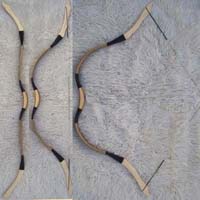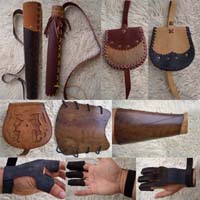Exploring the Differences Between Hungarian, Mongolian, Hun, Avar, and Laminated Bows
Archery has a rich history across cultures, and as a result, many different types of traditional bows have evolved to meet the unique needs of various regions and peoples. Each bow has its own distinct features, construction methods, and performance characteristics. In this blog post, we’ll explore some of the most notable traditional bows, including Hungarian, Mongolian, Hun, Avar, and laminated bows, highlighting their differences and historical significance.
1. Hungarian Bows: Elegance and Power
Hungarian bows are renowned for their elegant design and formidable power, often associated with the skilled mounted archers of the Hungarian plains. The Hungarian bow, particularly famous during the medieval period, is a type of shortbow, which was well-suited for mounted archery.
Key Features of Hungarian Bows:
- Shape: Hungarian bows typically have a slightly reflexed shape, meaning they curve away from the archer when unstrung, giving them more power with a compact design.
- Size: These bows are relatively short, making them ideal for use on horseback, where space and maneuverability are essential.
- Materials: Traditionally, Hungarian bows were made from composite materials, combining wood, horn, and sinew to create a strong, flexible bow that could withstand the forces of mounted archery.
- Design: The grip of a Hungarian bow is often smaller and placed closer to the center, which allows for better control during rapid, on-the-move shooting.
Hungarian archers, often using these short, powerful bows, became famous for their accuracy and speed, especially during battles and raids. The design of these bows is deeply tied to their role in cavalry, with an emphasis on quick draws and swift, lethal shots.
2. Mongolian Bows: Superior Craftsmanship for Mounted Archery
Mongolian bows are perhaps some of the most iconic traditional bows in history, known for their incredible power and compact design. These bows were developed by the Mongols, who mastered the art of mounted archery and used their bows in battle with devastating effect.
Key Features of Mongolian Bows:
- Shape: Mongolian bows are often reflexed (curved away from the archer), similar to Hungarian bows, but they tend to have more pronounced curvature at both ends.
- Materials: The bow is made of composite materials: wood for the core, with layers of horn and sinew for additional strength and flexibility. These materials allowed Mongolian bows to be incredibly strong and able to deliver powerful shots from horseback.
- Size: Like Hungarian bows, Mongolian bows are compact and designed for mounted archery. Their short length made them easy to handle and shoot while riding at full speed.
- Grip: The grip is placed lower on the bow, allowing for a comfortable and stable hold during high-speed maneuvers on horseback.
The Mongolian bow is often praised for its high efficiency in battle, enabling the archer to shoot accurately even while riding at full gallop. This design was pivotal in the success of the Mongol Empire, as their cavalry was renowned for their ability to shoot with deadly accuracy at long distances.
3. Hun Bows: The Legacy of the Steppe Warriors
Hun bows, like Mongolian and Hungarian bows, come from the vast steppes of Central Asia and were used by the Huns, a nomadic people who were known for their swift raids and mastery of mounted archery.
Key Features of Hun Bows:
- Shape: The Hun bow is typically a reflexed shortbow, designed for efficiency in both combat and hunting. It often features a single curve and a relatively simple design.
- Materials: Historically, Hun bows were made from wood and horn materials, often reinforced with sinew. These composite materials made them durable and flexible, capable of handling the stresses of long-range shooting.
- Size: These bows were relatively short, allowing Hun archers to fire quickly and accurately while on horseback.
- Use: The Hun bow was essential for hit-and-run tactics and was used with great skill during the rapid cavalry maneuvers that were a hallmark of Hun military strategy.
Hun bows are legendary for their effectiveness in the hands of skilled archers, who would shoot arrows from horseback with precision, often hitting targets at impressive ranges.
4. Avar Bows: A Fusion of Power and Precision
The Avars, who settled in Central Europe and interacted with other nomadic peoples, also developed a distinct type of bow. The Avar bow, though similar to the Mongolian and Hun bows, had its own unique features.
Key Features of Avar Bows:
- Shape: Avar bows were often short and reflexed, similar to other steppe bows, but sometimes with a slightly more pronounced curve for added power.
- Materials: Like the Mongolian and Hun bows, Avar bows were made from composite materials—wood, horn, and sinew. The Avar’s use of sinew was particularly important in creating a flexible, durable bow that could withstand harsh conditions.
- Design: The Avar bow typically had a low grip and was designed for quick shooting, which suited their role in rapid raids and battles.
Avar archers played a significant role in the history of Central Europe, particularly during their invasions and interactions with the Byzantine Empire. Their bows were renowned for their effectiveness in both mounted and foot archery.
5. Laminated Bows: The Modern Twist on Traditional Craftsmanship
Laminated bows are a modern evolution of traditional bows, combining the craftsmanship of old with modern materials. These bows use layers of different materials, often including wood, fiberglass, and carbon fiber, to create a bow that is both strong and lightweight.
Key Features of Laminated Bows:
- Shape: Laminated bows can come in a variety of shapes, including recurves and longbows. They tend to be more versatile than purely traditional composite bows.
- Materials: The use of modern materials like fiberglass or carbon fiber in laminated bows allows them to offer superior strength and flexibility without compromising on durability. Traditional wood may still be used as the core material.
- Performance: Laminated bows offer better consistency and longer lifespan than many traditional bows, as modern materials help prevent warping and ensure stable performance.
- Customization: Laminated bows are often custom-built to the archer’s specifications, offering a great deal of flexibility in design.
Laminated bows are favored by modern archers who seek the performance benefits of traditional designs while taking advantage of advancements in materials science.
Conclusion: The Evolution of Traditional Bows
Each of these traditional bows—Hungarian, Mongolian, Hun, Avar, and laminated—has its own unique design and historical significance. From the power and compactness of the Hungarian and Mongolian bows to the advanced materials used in laminated bows, each type has been developed to suit the specific needs of its culture, military tactics, and way of life.
At RECURVEBOWSHOP, we honor the traditions of archery by offering a variety of high-quality bows, from historical replicas to modern laminated designs, crafted with precision and care. Whether you are drawn to the history of the steppe warriors or the craftsmanship of Hungarian archers, we have the perfect bow for your needs.


